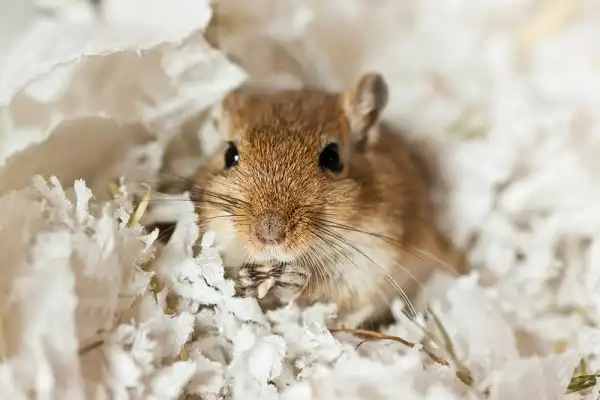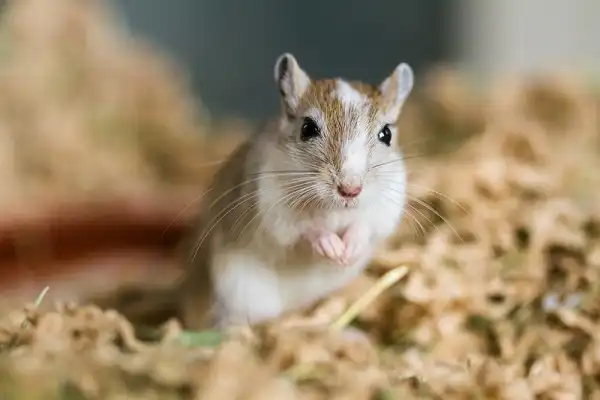Are you looking for a small, cheerful pet to fill up your days with joy and laughter? Look no further – the gerbil is an ideal choice! With their adorable big round eyes, physical agility, and overall friendliness towards humans, these little bundles of joy have been known to win hearts all around the world. Suitable both as indoor pets or outdoor explorers (depending on how secure your garden is), they are an asset not just to animal lovers but also those looking into educational opportunities. Science classes often study their behavior in depth as well as explore psychology research conducted using them as test subjects. Discover more about these delightful creatures by reading this blog post!

Gerbil Description
Gerbils are small and furry rodents with big, round eyes that instantly captivate anyone they come into contact with. They typically have soft brown fur and thick tails, both of which help them in their natural ability to tunnel through the ground. Contrary to popular belief, these little critters are not hamsters! Gerbils have significantly longer ears and tails than their hamster cousins. Gerbils make great pets for several reasons. Firstly, they are relatively easy to take care of as long as you keep their environment clean and provide ample food and water. Additionally, they are extremely social creatures who love interacting with people; so long as you treat them kindly and give them plenty of attention throughout the day, gerbils can quickly become your best friends!
Gerbil Habitat
Gerbils are naturally found in the deserts and semi-arid regions of Central Asia and Africa. While they may be considered small creatures, gerbils can dig burrows that span up to 2 feet deep into the ground! This helps them remain safe from predators while also providing them with a cool shelter during the hot summer months. In captivity, however, it is important to provide them with a habitat that meets their needs—namely space, safety, and stimulation. As such, the best way to house your gerbil is to purchase a cage specifically designed for them. These cages should be large enough to accommodate multiple levels of play and exploration; they should also have solid walls made out of heavy-duty wires or glass panels to ensure your gerbil’s safety. Furthermore, it’s also important to include various chew toys and other objects that your pet can use for entertainment purposes as well as exercise. Finally, you will need to make sure that the temperature within the cage is suitable for your gerbil—the ideal range being between 68-75°F (20-24°C). Additionally, you should provide good ventilation as gerbils tend to require more oxygen than other animals due to their active lifestyle. With all these points taken into consideration when creating a habitat for your gerbil, you are sure to have a happy and healthy pet companion that will bring much joy into your life!

Gerbil Diet
Gerbils are omnivorous creatures, meaning they eat both plant and animal matter. In the wild, their diet encompasses a variety of seeds, insects, fruits, and vegetables. To replicate this in captivity, it is important to provide them with a balanced diet that contains proteins and carbohydrates from both plant-based and meat-based sources. A staple gerbil meal should include a mix of high-quality whole grains such as oats, millet, and barley; these should be complemented by fresh fruits and vegetables like apples, carrots, broccoli, and spinach. Protein can come from commercially available insect larvae such as mealworms or waxworms—these should be fed sparingly as treats rather than served as part of everyday meals. Additionally, you can also give your gerbil small portions of lean meats such as boiled chicken or turkey every once in a while for added protein content. Furthermore, it is important to ensure that your gerbil always has access to fresh drinking water so they stay hydrated throughout the day. Additionally, if you want to give your gerbil some extra nutrients you can add supplements like calcium carbonate or vitamin drops to their food.
Gerbil Size
Gerbils are typically small creatures, measuring only 4 to 6 inches (10 to 15 cm) in length. On average, they weigh between 1.5 and 3 ounces (44 to 85 grams). Their fur is usually soft and short in length and can come in a variety of patterns and colors. Generally speaking, gerbils have brown-grey bodies with white or yellow bellies while their legs and tails tend to be darker in color. Interestingly, gerbil sizes vary by species; the Mongolian gerbil is the largest type of gerbil, reaching up to 7 or 8 inches (17 – 20 cm) in length, while the dwarf species—such as the Roborovski gerbil—are often much smaller at just 2 inches long! Despite this variation, all types of gerbils have an incredibly quick metabolism which helps them maintain their petite size.
Gerbil Lifespan
Gerbils are known for their relatively long lifespans, with some individual gerbils living for up to 5 years. However, the average gerbil’s lifespan can range from 2 to 3 years depending on factors such as genetics, diet and environment. With proper care and nutrition, gerbils can live longer healthier lives. When it comes to diet, it is essential to provide your pet with a balanced diet that includes a variety of nutrient-rich whole grains, fresh fruits, and vegetables as well as lean meats like boiled chicken or turkey. Additionally, providing your gerbil with supplements like calcium carbonate or vitamin drops can also help them stay healthy and active throughout their lifetime. Another important factor in determining a gerbil’s lifespan is its environment; it should be kept in an enclosure that is clean and free of any potential hazards. It should also be large enough to accommodate all the necessary items including bedding, toys, and water bottles while still allowing enough room for your pet to move around comfortably.

Gerbil Behavior
Gerbils are curious, active creatures that love to explore their environment. They are social animals that typically live in large colonies of up to 30 individuals with highly-defined hierarchies. In the wild, gerbils communicate with each other through various vocalizations, touch, and scent markings. At home, they prefer to remain in pairs or small groups and will form strong bonds with their owners if given lots of attention and interaction. Gerbils show affection to their companions by grooming them and snuggling up together for warmth. They are also very playful animals who love exploring new places and objects as well as engaging in activities like hoarding food and digging tunnels! These critters will also express excitement when a new toy or treat is presented to them; they’ll even come running up when you call their name! Despite being mainly nocturnal, gerbils are energetic animals who enjoy spending time outside of their cages; this is important for providing your pet with plenty of exercises which helps keep them healthy and happy.
Gerbil Speed
Gerbils are known for their small size and remarkable speed. They have powerful hind legs that enable them to jump up to 12 inches (30 cm) in the air and run up to 8 mph (13 km/h). This agility enables them to escape from predators, explore their environment, and hunt for food quickly. Additionally, gerbils have a very good sense of direction which helps them remember where their burrows and food sources are located. Gerbils also have a special adaptation called a “pouch” which allows them to store extra food items such as grains, seeds, or nuts inside it while they move around. This pouch is located near their stomachs, giving them an even greater ability to carry large amounts of food while running quickly.
Gerbil Hunting
Gerbils are well-known for their excellent hunting skills. They possess sharp claws and powerful hind legs that enable them to quickly dig through soil and debris in search of food. Gerbils have been observed engaging in a variety of hunting techniques, such as chasing and pouncing on their prey, cornering them against walls or objects, and digging up underground burrows. In addition to hunting for food, gerbils are also known to hunt for fun; they enjoy playing with their prey before catching it and will often attempt to ‘herd’ small surfaces around the environment. This behavior is thought to be an instinctive trait that evolved due to living in large colonies in the wild, where they must compete with other gerbils for resources. Gerbils use their sense of smell to locate their prey, relying on both chemical cues and visual cues. Once they’ve located the target, they will use a combination of speed and agility to catch it. Gerbils are also able to detect vibrations from far away which helps them identify potential prey even when it’s hidden.

Conclusion
Gerbils are small and fast-moving rodents that make wonderful pets for adults and children alike. With their impressive speed, climbing abilities, and excellent hunting skills, gerbils are not only cute but also fascinating to watch! Furthermore, with proper care from their owners, they can live long happy lives full of stimulating activity. So if you’re looking for a unique pet that’s sure to bring lots of joy into your life, consider getting a gerbil!
Frequently Asked Question


